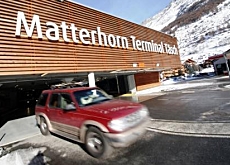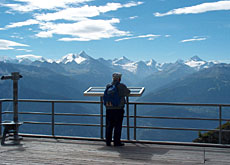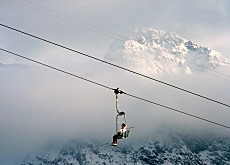What drives skiers to the slopes?

Why do eight out of ten skiers in Zermatt travel there by car when they could hop on an hourly train that drops them in the heart of the village?
Even though Switzerland has one of the densest public transport networks in the world, it is fighting a losing battle convincing residents to leave their cars at home to reduce harmful carbon dioxide emissions.
While the world envies the Swiss public transport system, the Swiss railways and bus line operators are in fierce competition with an excellent road network that is relatively uncongested, at least compared with other industrialised countries.
The Swiss are spoiled for choice and often base their transportation decisions on price and convenience.
“People want to be flexible during their free time,” Andreas Blumenstein of the Bern-based transport consultancy, büro für mobilität, told swissinfo.
“When they go somewhere on their days off, they usually have luggage or sports gear with them. It’s a logistical problem.”
Initiatives
Blumenstein says a door-to-door service is possible, even if such solutions are still in the early stages of development. But, he adds, a government-sponsored project, SpediBEO, is on the right track.
The luggage delivery service allows hikers to drop their bags at any one of a number of participating railway stations in the Bernese Alps by 9am in the morning, and pick them up at any other by 6pm.
But, as Blumenstein points out, “there also needs to be a way of getting people’s gear from their homes to the station at the start of their holiday”.
The Swiss Alpine Club (SAC) ran a three-year pilot project, AlpenRetour, which appealed to its environmentally aware members to take the train or bus instead of the car.
The SAC’s 98,000 members log about ten million kilometres a year to get from their homes to mountain trailheads. More than half of the SAC branches took part in the project and they reported that the use of public transport increased from 45 to 70 per cent for trips organised by the SAC.
Blame
Jöri Schwärzel, who headed Alpenretour, says the average skier needs more convincing. He blames ski lift operators for not doing enough to promote public transport.
“They are becoming more and more irresponsible when it comes to the environment,” he told swissinfo, pointing out that many operators in canton Graubünden have stopped granting discounts to Swiss rail pass holders.
Which brings the story back full circle to Zermatt. The resort’s mountain lifts and railway company has just opened a SFr80 million ($66 million) state-of-the-art car park for 2,000 vehicles to make driving to the resort more convenient.
It’s ironic that Zermatt, like a handful of other high-altitude Swiss resorts, is a “car-free” village.
The car park is integrated into the railway station at the neighbouring village of Täsch, which is where drivers must leave their vehicles before making the rest of the journey to Zermatt by train.
Fumes
Tourist director Roland Imboden says visitors value the fact that they are not bothered by car exhaust fumes in Zermatt, yet still prefer to drive to the destination. “Luggage is a problem, and most people probably believe it’s less expensive and more convenient to drive,” Imboden told swissinfo.
He says that could change with the opening of the new transalpine Lötschberg railway tunnel in December 2007, which will shorten journeys from northern Switzerland’s urban areas by about an hour, making the train more competitive.
He adds that more and more tourists are hiring skis in the resort, meaning they have less to carry and therefore may be more inclined to travel by rail.
“When we ask guests why they come to Zermatt, the first reason is to see the Matterhorn, the second is because they like the skiing and hiking here, and the third is because it’s car free.”
swissinfo, Dale Bechtel
CO2 emissions account for 83 per cent of the greenhouse gases Switzerland releases into the atmosphere.
If Switzerland is to meet its Kyoto targets and reduce greenhouse gas emissions by 8 per cent compared with 1990 levels, it will have to make progress on transport.
This sector has increased its emissions significantly since 1990. But there is great potential for a reduction since 40 per cent of all road journeys in Switzerland are considered unessential – for leisure activities such as going skiing, to the gym, or holiday travel.
Leisure activities account for 40% of all car trips in Switzerland, and 44% of distances travelled by road.
Transport is responsible for a third of carbon dioxide emissions in Switzerland.
In 2003, 44.7 million tons of carbon dioxide were emitted in Switzerland – more than six tons per person.
The federal offices for the environment, energy and spatial development are setting aside SFr1 million ($820,000) this year to promote innovative and sustainable transport.
The aim is to encourage people to switch to eco-friendly transport, fill gaps in the transport chain or to promote the development of innovative traffic strategies.
Leisure and tourism is one of the focus areas, with special emphasis on sports and events and solving the problem of the “last mile” (door-to-door service).
Funding will be awarded to projects deemed to have potential for improving energy efficiency and reducing CO2 emissions.

In compliance with the JTI standards
More: SWI swissinfo.ch certified by the Journalism Trust Initiative



You can find an overview of ongoing debates with our journalists here. Please join us!
If you want to start a conversation about a topic raised in this article or want to report factual errors, email us at english@swissinfo.ch.